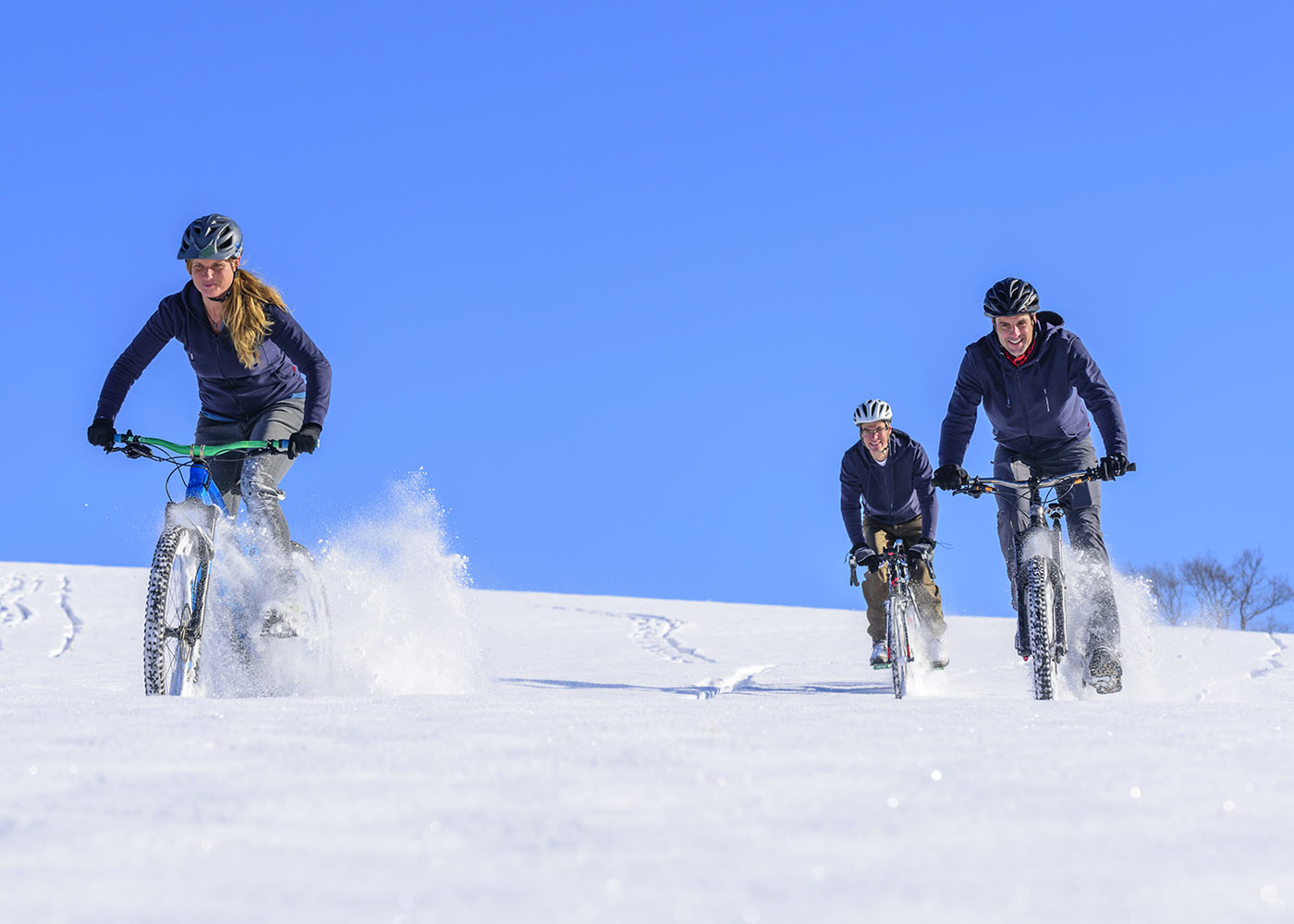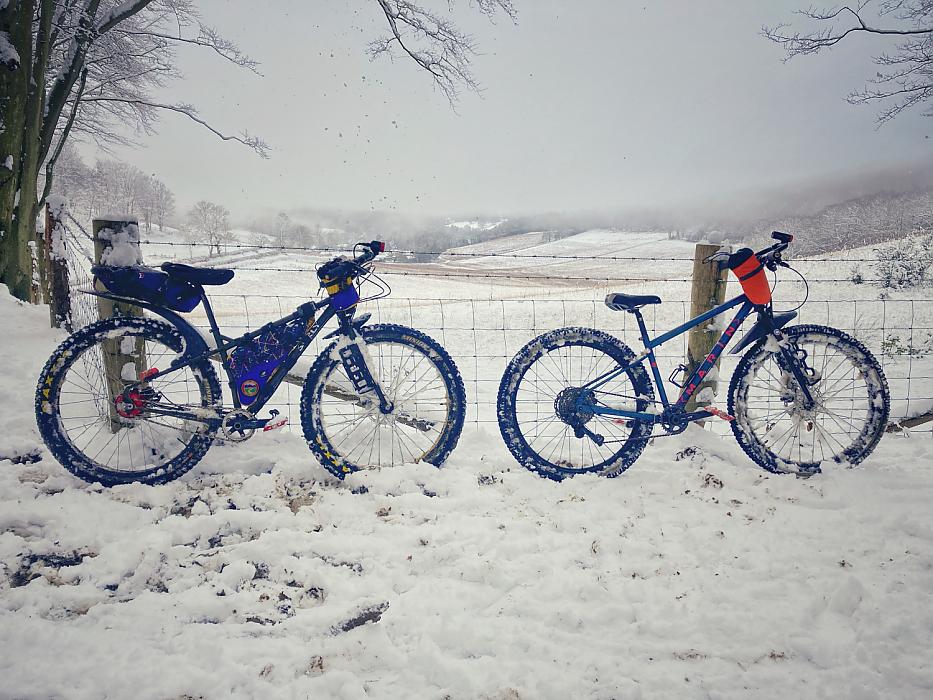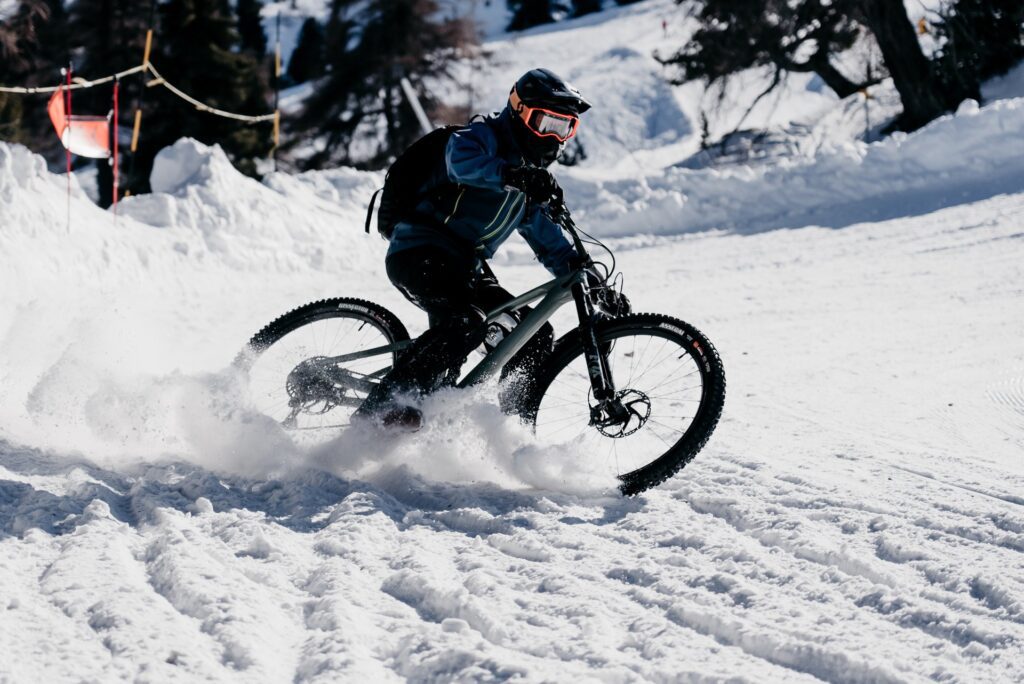


Imagine a winter wonderland, blanketed in a glistening coat of fresh snow. The snowy view is beautiful, and you might want to ride your mountain bike in these winter months. But “Can You Ride A Mountain Bike In The Snow?” In simple terms, “Yes, you can.” By fixing your bike, using good equipment, and riding carefully, you can enjoy snowy trails.
However, there are a few important things to consider. In this article, we’ll explain why snow and ice biking is fun for everyone, whether you’re young or old. So, let’s dive in and discover the thrilling world of snow biking!
Ready for Snow Biking: The Must-Haves



“Equip yourself with the right gear for snow riding, for it is the key to unlocking the frozen wonders of the trails. From studded tires to insulated clothing, gear up and embrace the exhilarating experience of riding on snow-covered terrain.”
Are you excited about trying snow biking? It’s a fantastic winter adventure! But before you hit those snowy trails, there are a few important things you must have. In this article, we’ll discuss the important things you need for a fun and safe snow-biking adventure.
1. Special Snow Tires:
Regular bike tires won’t work well in the snow. You need special snow or fat bike tires. They are wider and provide better traction on snowy terrain, helping you stay upright and in control.
2. Warm Clothing:
The weather is chilly out there! Dress warmly with layers to stay cozy. Don’t forget gloves, a winter hat, and a good jacket to keep your body, hands, and feet warm throughout your ride.
3. Eye Protection:
Snow can be bright when the sun is out. Sunglasses or snow goggles will help protect your eyes from the sun’s glare and the wind.
4. Lights:
Days are shorter in winter. If you plan to ride when it’s getting dark, bike lights are a must for safety. Night riding will be a unique and thrilling experience for you.
5. Maintenance Kit:
It’s important to check your bike before you ride, especially in cold conditions. Make sure your brakes, gears, and chains are working smoothly. Carry some basic tools and spare parts just in case.
6. Water and Snacks:
Even in the cold, you need to stay hydrated and energized. Carry water and high-energy snacks to keep you going.
7. Plan Your Route:
Before you head out, plan your route and let someone know where you’re going. Snow can make trails harder to follow, so it’s important to have a plan.
8. Learn Snow Biking Skills:
Snow biking is different from regular biking. Try balancing and practicing braking in a secure place before tackling tough trails.
9. Stay Safe:
Always wear a helmet and be cautious. Snow biking can be slippery, so take it slow and be careful on downhill sections.
10. Respect Nature:
Snow biking is a great way to enjoy the winter landscape. Make sure you respect the environment, stick to the trails, and don’t disturb wildlife.
Remember, riding in the snow can be tons of fun, but safety should always come first. With the proper equipment and being careful, you can enjoy biking in the snowy outdoors.
Read More: ” Is Mountain Bike Good For Beginners? “
Preparing Your Mountain Bike for Snow Riding: Essential Changes



Riding your mountain bike in the snow is like embarking on a frosty adventure. But before you set off, there are some important changes to make to your trusty bike. In this article, we’ll go over the important adjustments you need for a safe and enjoyable snow-biking adventure.
1. Special Snow Tires:
Your regular mountain bike tires won’t cut it in the snow. You need snow-specific tires, often called fat bike tires. They’re wide tires and provide better grip and surface area in snowy conditions. These tires help you stay stable and in control on slippery surfaces.
Also, check the air pressure of the front wheels and rear wheels.
2. Lower Tire Pressure:
To gain even more traction, let some air out of your snow tires. This increases the contact area with the ground, giving you a better grip on the snow. Just remember not to go too low to prevent damaging the rims.
3. Check Your Brakes:
Snow riding means you’ll need excellent stopping power. Ensure your brakes are in good condition, and the pads have enough life left. Adjust the brake levers to your preference, making sure you can reach them comfortably, even with gloves on.
4. Lubricate Moving Parts:
The cold and wet can affect your bike’s moving parts, like the chain and gears. Apply a cold-weather bike lubricant to prevent freezing or jamming. Keeping your bike well-lubricated ensures a smoother ride.
5. Protect the Frame:
Snow, salt, and slush can be harsh on your bike’s frame. Applying a protective coating, like silicone spray or frame tape, can help shield it from the elements. It’s like giving your bike a winter jacket!
6. Dress for the Weather:
Remember to take care of yourself! Wear warm clothing in layers to stay comfortable. A winter hat, gloves, and a good jacket are essential to keep you cozy while riding in the cold.
7. Lights for Visibility:
Days are shorter in winter, so invest in good bike lights. They’ll not only help you see but also make sure others can see you.
8. Carry Essentials:
Pack some essentials for your snow adventure, like a multi-tool for quick fixes, spare tubes, and a small pump. It’s wise to get ready for unexpected situations.
9. Lower Your Saddle:
To gain more stability and control, think about lowering your saddle a bit. This allows you to touch the ground more easily, making it simpler to balance in slippery conditions.
10. Adjust Your Riding Style:
Snow biking requires a different approach. Take it slow, especially on descents, and be gentle with your movements. Practice, braking, and turning in a safe environment to get the hang of it.
Your mountain bike is all set for winter rides by making these necessary changes and being cautious.
Read More : ” Is Mountain Biking Safe? “
Pros and Cons of Riding a Mountain Bike on Snow



Riding a mountain bike on snow has its upsides and downsides. Let’s take a look at the upsides and downsides of this snowy adventure.
Pros:
- Winter Wonderland Fun:
Biking in the snow is a thrilling winter adventure, adding excitement to the season.
- Scenic Views:
Snowy trails offer stunning, unique scenery you won’t find any other time of the year.
- Gentle Exercise:
It’s a low-impact workout, putting less stress on your body compared to high-impact activities like running.
- Balance and Control:
Snow biking can make you better at balancing and controlling your bike.
- Quiet Trails:
Winter is the off-season, so you can enjoy peaceful rides with fewer crowds and noise.
Cons:
- Slippery Paths:
Snow can make trails slippery, requiring extra caution and skill.
- Chilly Temperatures:
You’ll need to dress warmly, as the cold weather can be uncomfortable.
- Special Gear Needed:
Snow biking needs special gear, which might cost more and take extra effort.
- Limited Trail Access:
Not all trails are suitable for snow biking, with some closing during winter.
- Maintenance Challenges:
Snow and cold weather can be tough on your bike, demanding more frequent cleaning and maintenance.
Even though snow biking is fun, remember to think about the good and bad before you start riding.
Read More: ” Can You Ride A Mountain Bike On Pavement? “
Final Verdict(Can You Ride A Mountain Bike In The Snow)
In conclusion, the answer to the question “Can You Ride A Mountain Bike In The Snow?” is a resounding Yes, mountain bikes are suitable for snowy terrains, making for a thrilling winter pursuit. By fixing your bike, using good equipment, and riding carefully, you can enjoy snowy trails.
While there are some challenges, with proper preparation, snow biking can be a safe and thrilling adventure. For a fresh winter adventure, ride your mountain bike on the snowy trails and have fun while being safe.
FAQs:
Can I use a mountain bike in the snow?
Yes, you can use a mountain bike in the snow. With the right tires, adjustments, and techniques, riding on snowy terrain can be a thrilling and rewarding experience.
What mountain bike for riding in snow?
For riding in snow, it’s recommended to use a mountain bike with fat tires. Fat bikes provide better traction and stability on snowy surfaces, allowing for an enjoyable winter riding experience.
Do bikes have snow tires?
Yes, there are specific tires called “fat tires” designed for riding in snow. These wider tires with deeper treads provide better grip and traction on snowy surfaces.
Is snow biking easy?
Snow biking can be more challenging compared to regular biking due to the unstable surface and reduced traction. However, with practice and the right techniques, it can be an enjoyable and exhilarating experience.
What kind of bike do you use in the snow?
For riding in the snow, it’s recommended to use a fat bike. Fat bikes have wider tires with low pressure, providing better traction and stability on snowy surfaces.



Welcome to Bikegenics, where passion meets performance! We are a leading online destination for all things related to mountain biking, dedicated to providing you with top-notch gear, expert advice, and an immersive community to fuel your two-wheeled adventures. With a commitment to excellence and a deep love for the sport, we strive to elevate your biking experience to new heights.
